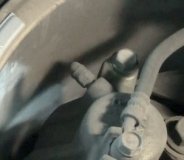You might need to bleed the brakes in a certain oder to assure there is no air in the system. Follow this procedure;
The right rear is farthest from the master cylinder and it takes along time to get fluid to pump to it especially with a new master cylinder.
To bench bleed the master cylinder, it should have came with a kit to do this, but if not get some short brake lines that if bent around will connect to master cylinder outlets and then cut off the other end so that it will reach the bottom of the master cylinder reservoir. Then make sure the fluid level never gets low in any of the bleeding process. Now pump kind of rapidly at the master cylinder for a while and then pump it normally until there are no air bubbles coming out of the holes in the bottom of each reservoir.
Now to bleed the brakes you need to get some pliable clear tubing that you can get at Home Depot. It needs to fit snugly over the bleed nipple and be long enough to run it over something that will hold its highest point above the caliper and then run it into a plastic bottle or jug till the hose goes to the bottom.
Start bleeding at the farthest caliper away from master cylinder and work closer to it. So, the right rear first, the drivers rear second, right rear third and then the drivers side front.
Fit one end over the bleed screw and run the line higher than the bleed screw then into the bottle. Put a little axle grease on the threads and once you get some of the air out, you can just keep flushing fluid without stopping to hold and release and tighten bleed screw. Since you have so many issues, I would suggest flushing it until it comes out clean.
Starting at the right rear caliper, (This is the farthest from the master cylinder and needs to be done first.)Pump and hold but you can also just pump if the level in the master cylinder is dropping. It takes a while to get fluid going from such a far place especially with a new caliper. To create the pressure to get the fluid going, it has to fill a large cavity the the master cylinder is not designed for. The master cylinder only moves a little bit of fluid when you use your brakes. So be patient, it will come.
If the pedal gets hard to pump, there is contamination somewhere and is often in the bleed screw. Remove it and clean it out.
Now move on to the drivers' side rear brake. Then the passenger side front brake. Then lastly the drivers front brake.
This system of working farthest away from the master cylinder to the closest helps remove the most contamination and helps more fluid to move along.
ALSO, never let the master cylinder get below the low mark. That will pump air into the brakes. If you think bleeding the farthest caliper is hard, a master cylinder is a killer to bleed.
Also, check the level of the master cylinder to see if it is the same as when you first bled them. This will indicate if there is a small leak. Also try pumping the brakes when the pedal begins to drop as this will tell you if there is air in the system. If the pedal gets stiffer, there is air in the system.
Another possibility, but remote with the symptoms you desribe, is the power brake booster. On some Fords the power steering provides the power assist, on others it is a vacuum boost. The way to tell is if there is a lrage round disk or, "two pie pans facing each other", that the master cylinder is attached to. If it is the larger cylinderical object, it is vacuum assist. Check the vacuum line for leaks that runs from the booster to the intake manifold. Also before starting the truck, pump the brake and keep your foot on the pedal. Now start the truck and the pedal should drop away under your foot. That is an indication that the booster is working properly.
I hope this information helps.
Saturday, May 5th, 2012 AT 12:22 PM


